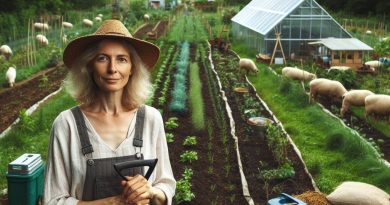Polyculture Farming: Diverse Crops, Better Yield
Last Updated on November 27, 2023
Introduction
A. Definition of Polyculture Farming
Polyculture farming involves cultivating a variety of crops simultaneously on the same piece of land. It’s a departure from traditional monoculture.
B. Importance of Diverse Crops in Farming
- Enhances Soil Health: Different crops extract and deposit varying nutrients, fostering a balanced soil ecosystem.
- Pest Control: Diverse crops disrupt pest cycles, reducing the risk of infestations without relying heavily on chemicals.
- Improved Resilience: Various crops respond differently to environmental changes, ensuring stability against unpredictable conditions.
C. Thesis Statement
Polyculture Farming Promotes Better Yield Through the Cultivation of Diverse Crops
Embracing polyculture is not just an ecological choice; it’s a strategic move towards sustainable farming practices, yielding benefits beyond monoculture limitations.
Benefits of Polyculture Farming
Polyculture farming, also known as mixed cropping or intercropping, involves cultivating multiple crops together in the same field.
This method contrasts with monoculture farming, where only one type of crop is grown.
Polyculture farming has gained popularity in recent years due to its numerous benefits and potential for sustainable agriculture.
A. Increased biodiversity
One of the major advantages of polyculture farming is increased biodiversity.
1. Polyculture farming provides natural pest control
By growing various crops together, farmers create a diverse ecosystem that attracts a wide range of beneficial insects, birds, and other organisms.
This enhanced biodiversity provides natural pest control by reducing the population of harmful pests, minimizing the need for pesticides.
2. Enhances soil quality and nutrient cycling
Moreover, polyculture farming enhances soil quality and nutrient cycling.
Different crops have varied root structures, which can penetrate the soil to different depths.
This helps improve soil structure, enhancing its ability to retain water and nutrients.
Additionally, diverse crop species have differing nutrient requirements, reducing the depletion of specific nutrients in the soil and maintaining overall soil fertility.
B. Risk mitigation
Risk mitigation is another significant advantage of polyculture farming.
1. Reduces vulnerability to pests, diseases, and climate change
By cultivating multiple crops, farmers reduce their vulnerability to pests, diseases, and climate change.
If one crop is affected, other crops can still thrive, ensuring a stable production system.
This resilience safeguards farmers against potential crop failures and economic losses.
C. Improved soil fertility
Polyculture farming also contributes to improved soil fertility.
1. Crop rotation and complementary relationships between plants
Crop rotation is a common practice in polyculture systems.
Different crops have different nutrient requirements, and rotating crops helps replenish soil nutrients while minimizing the risk of nutrient imbalances.
Furthermore, certain crops have complementary relationships, where one plant’s roots can excrete substances that benefit another plant growing nearby.
These interactions promote overall soil health and fertility.
2. Nutrient supplementation and reduced reliance on synthetic fertilizers
Additionally, polyculture farming reduces reliance on synthetic fertilizers by providing natural sources of nutrients.
The diversity of crops ensures that each plant contributes to the nutrient needs of the system.
Farmers can also use organic practices like cover cropping and composting to further enhance soil fertility.
This reduced dependence on synthetic fertilizers helps protect the environment and minimizes the risk of nutrient runoff, which can pollute water bodies.
To summarize, polyculture farming offers several benefits for farmers and the environment.
Increased biodiversity provides natural pest control, while enhanced soil quality and nutrient cycling improve overall soil fertility.
Risk mitigation through diversified crops ensures stable production, even in the face of crop failures.
By embracing polyculture farming, farmers can cultivate a sustainable and resilient agricultural system that minimizes environmental impact and maximizes yields.
Read: Crop Rotation: Boosting Soil Health Naturally
Factors to Consider in Polyculture Farming
Polyculture farming, also known as mixed cropping, is an agricultural practice that involves growing multiple crops together in the same area.
This method promotes biodiversity, enhances soil fertility, and provides economic benefits for farmers.
In this section, we will discuss the important factors to consider in polyculture farming.
A. Crop selection
One of the essential elements in polyculture farming is crop selection.
Farmers must identify compatible crops that can thrive alongside each other without competing for resources such as water, sunlight, and nutrients.
By choosing crops that complement each other, farmers can promote mutual growth and reduce the risk of crop failure.
Market demand and profitability are also crucial factors to consider when selecting crops for polyculture farming.
Farmers should conduct thorough market research to understand the demand for different crops and assess their potential profitability.
By growing in-demand crops, farmers can ensure a steady income and maximize their yield.
B. Planning and design
Proper planning and design are vital in polyculture farming to maximize the efficient use of resources and optimize crop growth.
Farmers should carefully plan the layout of their crops to make the most out of available space, sunlight, and water availability.
This strategic approach prevents overcrowding and ensures that each crop receives adequate resources for optimal growth.
Crop clustering is another effective technique in polyculture farming planning.
Grouping crops with similar resource requirements together allows for efficient management and resource sharing.
Compatible crops can benefit from each other’s presence, such as nitrogen-fixing plants providing nutrients to neighboring crops, reducing the need for synthetic fertilizers.
C. Sowing and harvesting practices
Timely sowing and proper spacing considerations are crucial elements in successful polyculture farming.
Farmers must understand the specific requirements of each crop regarding sowing time and spacing to ensure optimal growth and prevent competition for resources.
Careful planning and coordination are essential to avoid overcrowding or leaving excessive gaps between crops.
Harvesting techniques play a significant role in minimizing damage and maximizing yield in polyculture farming.
Farmers should employ appropriate harvesting practices for each crop to ensure minimal loss and maintain the quality of harvested produce.
Gentle handling, using proper tools and equipment, and careful post-harvest management are essential for preserving the overall productivity of the polyculture system.
In summary, polyculture farming offers numerous benefits through the cultivation of diverse crops.
To achieve success in this agricultural practice, farmers must consider various factors.
Efficient crop selection, proper planning and design, as well as strategic sowing and harvesting practices, contribute to better yield, improved resource utilization, and increased profitability.
By embracing polyculture farming, farmers can create sustainable and resilient agricultural systems while meeting the demands of a growing population.
Read: Agroforestry: Combining Trees and Crops Wisely

Successful Examples of Polyculture Farming
Polyculture farming has a long history of success, both in traditional farming practices and modern farming models.
A. Traditional farming practices
1. Intercropping in ancient civilizations (e.g., Mayans, Native Americans)
Traditional farming practices in ancient civilizations such as the Mayans and Native Americans utilized an intercropping technique where different crops were grown together.
This method allowed for efficient use of land and resources, resulting in better yields.
2. Practices in indigenous communities around the world
In addition to ancient civilizations, indigenous communities around the world have also employed diverse polyculture farming practices.
These communities have developed techniques that incorporate multiple crops and species, allowing for sustainable food production while preserving the ecosystem.
Their deep understanding of nature and biodiversity has helped them achieve better yields and maintain a balanced agricultural system.
B. Modern polyculture farming models
Modern polyculture farming models continue to build upon these traditional practices, incorporating new knowledge and innovations.
1. Permaculture systems
One such model is permaculture systems. Permaculture aims to create self-sustaining ecosystems by designing agricultural systems that mimic natural processes.
By integrating different plants and animals, permaculture systems can enhance nutrient cycling, pest control, and soil fertility, resulting in higher crop yields.
2. Agroforestry and silvopasture techniques
Agroforestry and silvopasture techniques are another example of successful modern polyculture farming models.
This technique involves growing trees alongside crops or livestock, creating a symbiotic relationship where the trees provide shade, nutrient cycling, and wind protection.
Silvopasture, on the other hand, combines trees with grazing livestock, improving forage quality and animal welfare.
Both techniques optimize land use and diversify income streams, leading to increased overall productivity.
3. Three Sisters method
One notable successful example of polyculture farming is the Three Sisters method practiced by Native American communities.
The Three Sisters consist of planting corn, bean, and squash together. The corn provides vertical support for the beans, while the beans fix nitrogen in the soil, benefiting both the corn and squash.
The squash acts as ground cover, reducing weed growth and moisture loss.
This synergistic combination maximizes yield and minimizes soil degradation, making it a sustainable and productive farming practice.
4. Sistema Agroflorestal
Another successful polyculture farming example is found in Brazil’s “Sistema Agroflorestal” (SAF), a form of agroforestry.
SAF combines fruit trees, timber trees, crops, and livestock in a harmonious system.
The trees provide shade, prevent soil erosion, and offer additional income through timber and fruits.
The crops and livestock benefit from the trees’ services while contributing to the overall productivity of the system.
SAF has proven to be economically and environmentally beneficial, offering higher yields and fostering ecological stability.
5. Rice-Fish-Duck
Furthermore, polyculture farming has shown success in rice production. In China’s Yunnan province, farmers adopted a polyculture system known as the “Rice-Fish-Duck” system.
Rice paddies are combined with fish ponds and duck habitats. The ducks eat insects and weeds, while their droppings provide natural fertilizers for the rice.
The fish feed on pests and organic matter in the water, resulting in pest control and nutrient recycling.
This integrated approach not only increases rice yields but also enhances biodiversity and reduces the need for chemical inputs.
Essentially, successful examples of polyculture farming can be found in traditional farming practices and modern farming models.
Indigenous communities and ancient civilizations have long practiced intercropping and diverse agricultural systems, resulting in improved yields and sustainability.
Modern models such as permaculture and agroforestry continue to build upon these traditional practices, showcasing the benefits of integrating different plants and animals to optimize land use and enhance productivity.
The success of polyculture farming is evident in various regions worldwide, proving that diverse crops lead to better yields and a more sustainable future.
Read: Urban Farming: Growing Food in City Spaces
Challenges and Potential Solutions
In addition to the numerous benefits, polyculture farming also presents its fair share of challenges.
These challenges range from management complexity to market limitations and require careful consideration and potential solutions to ensure the success of polyculture systems.
A. Management Complexity
One primary challenge faced by polyculture farmers is the management complexity of handling different crop requirements and growth patterns.
Unlike monoculture farming, where a single crop is cultivated, polyculture involves the simultaneous cultivation of diverse crops with distinct needs.
This complexity can make it more difficult to manage the farm efficiently.
Furthermore, time and labor-intensive practices are often necessary to maintain a productive and diverse crop system.
Polyculture farmers need to employ meticulous planning and execution to manage the various crops effectively.
This can involve staggered planting schedules, crop rotation, and precise monitoring of individual crop requirements.
B. Market Limitations
Matching diverse crop production with market demands is another significant challenge for polyculture farmers.
Traditional markets and supply chains are often geared towards monoculture crops, making it difficult for polyculture farmers to find appropriate outlets for their products.
Educating and attracting consumers to diverse products is crucial in overcoming these market limitations.
Raising awareness about the benefits of diverse crops and their nutritional value can help create demand for these products.
Moreover, developing direct-to-consumer marketing strategies and participating in farmers’ markets can provide an alternative distribution channel for polyculture farmers.
C. Knowledge and Training
Successful polyculture farming requires a deep understanding of various crops, their interactions, and sustainable agricultural practices.
Agricultural education and research play a pivotal role in equipping farmers with the necessary knowledge and training.
Government support and extension services are instrumental in providing training opportunities and disseminating research findings.
By offering workshops, seminars, and agronomic guidance, these institutions assist farmers in adopting and implementing polyculture farming practices.
In general, while polyculture farming offers numerous benefits, such as increased yield and ecological sustainability, there are challenges that need to be addressed.
These challenges include management complexity, market limitations, and the need for knowledge and training.
By identifying potential solutions and implementing appropriate strategies, polyculture farmers can overcome these obstacles and reap the rewards of diversifying their crop systems.
Read: Permaculture Basics: Nature’s Way in Agriculture
Conclusion
A. Recap of the benefits of polyculture farming
- Increased biodiversity, pest control, and disease resistance.
- Nutrient cycling and soil improvement through companion planting and intercropping.
- Resilience to climate change and extreme weather conditions.
B. Encouragement for farmers to adopt diverse crop cultivation methods
- Higher yields, increased income, and reduced input costs.
- Evidence of success from case studies and experienced farmers.
- Potential market demand for diverse and organic crops.
C. Final thoughts on the potential of polyculture farming
- The transformative power of polyculture farming in creating sustainable and resilient agricultural systems.
- The need for further research and knowledge-sharing to aid the widespread adoption of diverse crop cultivation methods.
- A call to action for farmers, policymakers, and consumers to support and prioritize polyculture farming for a more sustainable future.


